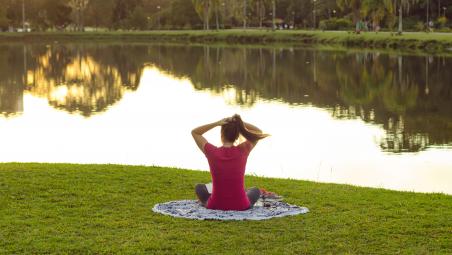It is not uncommon to see students and staff scrolling through social media on their devices during breaks between classes and at recess or lunch. If you don’t find yourself in the staff room at lunch, you are likely in your classroom replying to emails or checking off the ‘to do list’. We all return to class a bit more tired, a little more irritated, and no more refreshed than before the break began! The fact is the meaning of ‘break time’ has evolved and dissolved; we no longer seem to provide our brains with the breaks throughout the day that they need and deserve.
What I propose is that we all take a step away from our devices and tasks during breaks and instead take a step outside. You may even decide to grab a colleague to join you or encourage some students to do the same. Let’s disconnect to reconnect.
Technology v.s. Brain Break

We know that technology overuse can lead to psychological factors such as stress, anxiety, and depression (Lee et al., 2014). Research shows that devices actually impede the benefits of taking a break (Atchley et al., 2012; Jiang et al., 2018). Disconnecting from devices will not only help you and your students feel refreshed, but allow us the time to connect socially face-to-face.
The Benefits of Taking Quality Breaks Outside

Although it seems counter-intuitive, taking a break from work and leaving our devices behind can actually make us more productive.
Spending time outside paired with leaving technology behind for a moment can have immense effects on our wellbeing as well as academics and behaviour. In return, we can expect to feel and see increased focus and fewer behaviour outbursts - for both students and staff.
Additionally, the connection between our wellbeing and nature is clear; there is a lot of research that shows:
- Exposure to natural environments helps us recover from stress quicker than indoor/built environments (Pearson & Craig, 2014);
- Natural environments help us recover from mental fatigue more efficiently than indoor/built environments (Hartig et al., 2003);
- Outdoor spaces help us feel a sense of ‘being away’ similar to a vacation (just on a smaller scale) (Kaplan, 1995);
- When we are cognitively rested, we feel less impulsive, act nicer to others, and can solve problems better (Berto, 2014);
- Even brief contacts with nature can boost your mood (Capaldi et al., 2015);
- 20 minutes in nature is the ‘magic number’ for optimal benefits (Hunter et al., 2019);
There is no better time than the present to leave our devices behind and step outside for a breath of fresh air. Since we know that technology addiction is prevalent (Jiang et al., 2018) and time spent outdoors is lacking (Pearson & Craig, 2014), let’s disconnect to reconnect. Promoting peer social activities on the playground, inviting colleagues to take a walking meeting outside instead of in the classroom, or just taking a ‘time out’ from devices is a great way to model effective breaks throughout the day.
Need a Starting Point?

Check out this 1000 Hours Outside Challenge that you and your school/community could adapt to fit your context. One idea is to challenge staff vs. students to ‘fill in the dots’ on the template for a set date range; hang the poster template in a busy hallway and get your school community excited about colouring in the dots as they achieve outdoor hours. Create your own rules and guidelines such as active + outdoors = two dots, or if you spend time outside with friends (and no devices), you can colour a dot for each person; encourage social interactions that are face-to-face.



